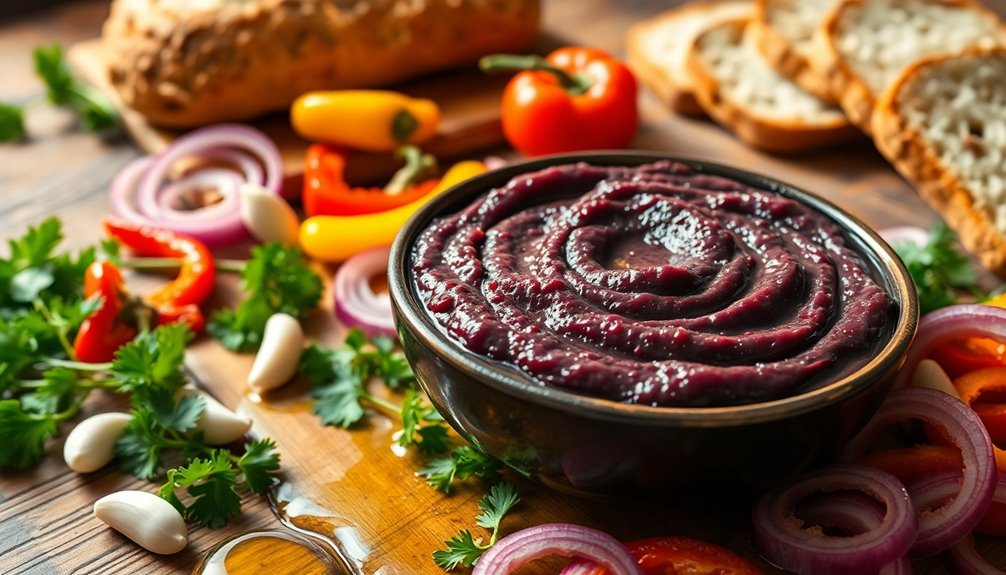Kyopolou is a delicious Bulgarian dish that highlights roasted eggplants and peppers, embodying the rich culinary traditions of the Balkans. It's perfect for featuring seasonal produce and is often enjoyed during Orthodox fasting periods. You'll love its smoky flavor enhanced with garlic, vinegar, and herbs, making it a versatile dip perfect for sharing with fresh bread. Curious about the history and how to make it? There's plenty more to explore about this vibrant dish!
History
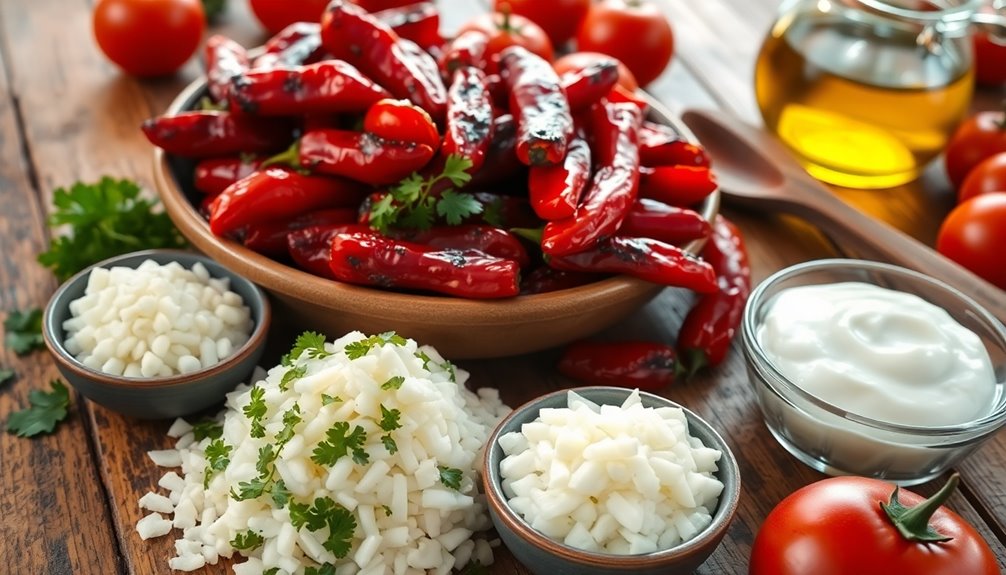
Kyopolou, a dish with deep roots in the Balkans, showcases the region's agricultural heritage by using seasonal produce like eggplants and peppers.
Kyopolou highlights the Balkans' agricultural heritage, celebrating seasonal eggplants and peppers in a beloved traditional dish.
This traditional Bulgarian food reflects the agricultural practices and cultural significance of communal dining, especially during Orthodox fasting periods like Lent.
Its name, derived from the Turkish word "köpoğlu," highlights the historical culinary exchanges between Bulgaria and Turkey, emphasizing how these two cultures have influenced each other's cuisines.
You'll find that similar dishes, such as ajvar and zacuscă, illustrate the diverse regional variations of eggplant-based relishes across the Balkans.
Kyopolou is often prepared using time-honored methods, ensuring its enduring place in Bulgaria's culinary heritage and popular appeal today. Additionally, the dish can be enhanced with raw food ingredients to align with contemporary dietary trends focused on health and nutrition.
Recipe
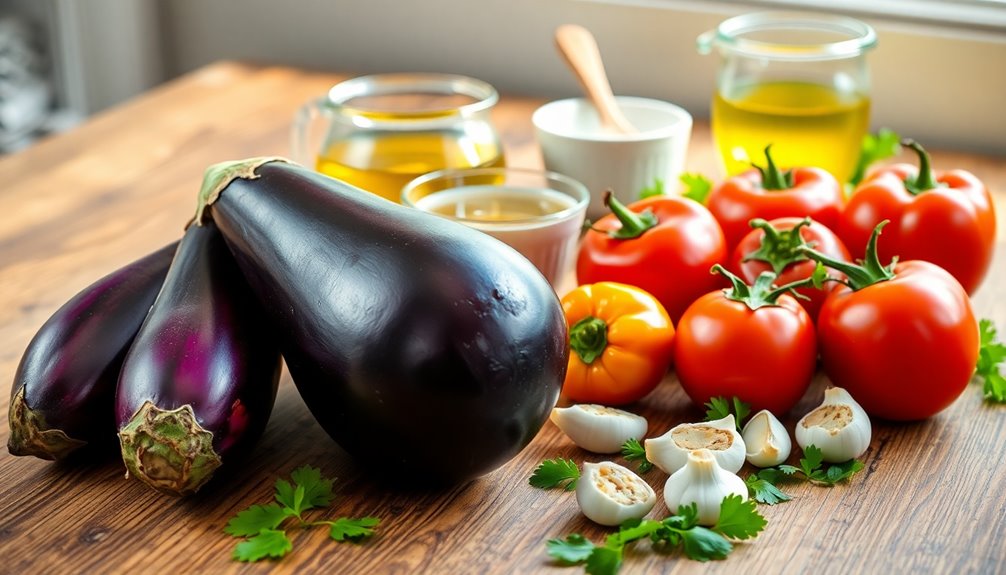
Kyopolou is a delightful traditional Bulgarian dish that captures the essence of summer flavors and can be enjoyed throughout the year. This vibrant condiment, made primarily from roasted eggplants and peppers, isn't only a staple in Bulgarian cuisine but also a versatile addition to various meals. Its rich taste, combined with the tang of vinegar and the freshness of herbs, makes Kyopolou an excellent choice for vegan diets, especially during fasting periods.
This dish is often prepared in larger batches for winter storage, making it a convenient option to have on hand. The roasting process enhances the natural sweetness of the vegetables, while the combination of garlic, vinegar, and oil creates a harmonious balance of flavors. Additionally, using organic farming methods can enhance the taste and quality of the fresh ingredients used in this recipe.
Whether served as a salad, a spread, or a side dish, Kyopolou is sure to impress with its delectable taste and appealing presentation.
Ingredients:
- 2 big eggplants
- 4 peppers
- 3 medium tomatoes
- 3 cloves of minced garlic
- 1 cup of vinegar
- 1/2 cup of oil
- 1 tablespoon of salt
- Chopped parsley (for garnish)
To prepare Kyopolou, begin by preheating your oven to 375°F (190°C). Place the eggplants and peppers on a baking sheet and roast them for about 10 minutes, or until they're tender and the skins are slightly charred.
Once roasted, remove them from the oven, allow them to cool slightly, then peel and chop the vegetables. In a large bowl, combine the chopped eggplants, peppers, tomatoes, and minced garlic, followed by the vinegar, oil, and salt. Mix everything thoroughly to ensure the flavors meld together.
Finally, transfer the mixture to a serving dish and sprinkle chopped parsley on top before serving.
When making Kyopolou, feel free to customize the recipe according to your taste preferences. You can adjust the amount of garlic for a milder or stronger flavor, or try substituting dill for parsley if you'd like a different herb profile.
Additionally, if you plan to can the dish for winter storage, ensure all equipment is properly sterilized to maintain freshness. This dish keeps well in jars and can be enjoyed for months, making it a perfect addition to your pantry.
Cooking Steps
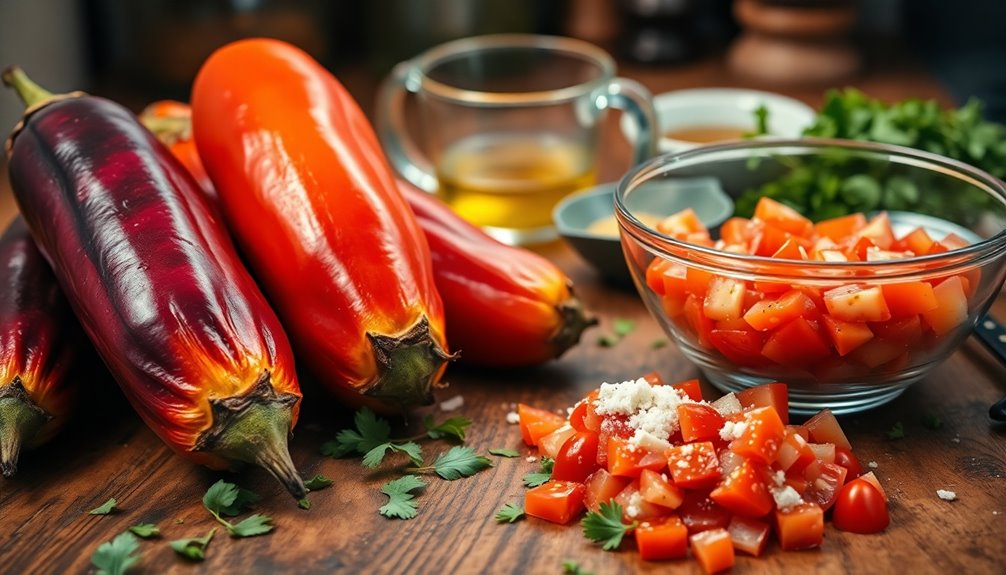
To start making Kyopoolu, you'll want to preheat your oven to 400°F.
Once that's set, chop your roasted vegetables finely for a perfect blend.
Finally, combine everything in a bowl with olive oil before serving it with fresh bread. Additionally, serving it alongside Dirt Cups can add a fun and playful dessert option to your meal.
Step 1. Preheat Oven to 400°F
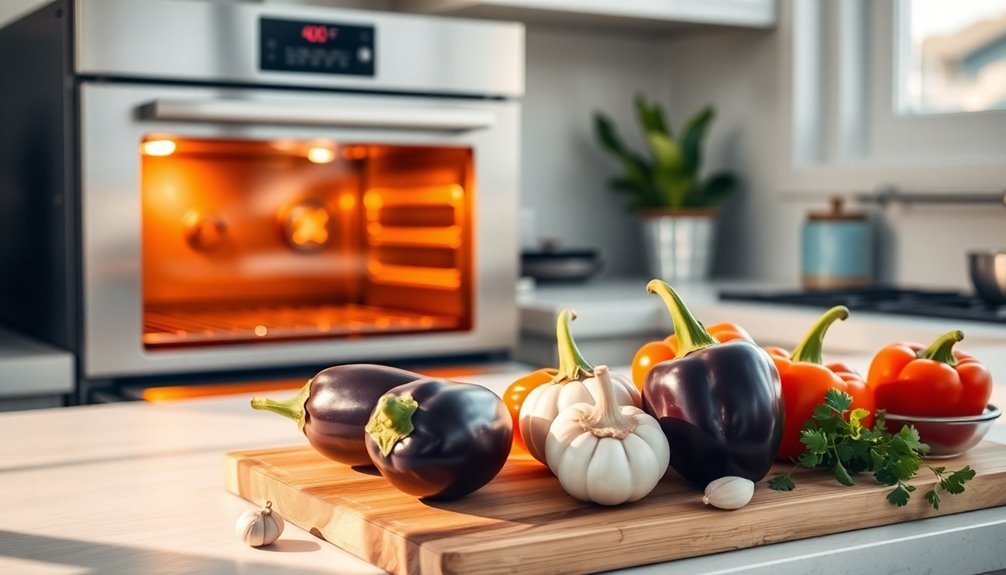
Preheating your oven to 400°F (about 200°C) is essential for roasting the vegetables that give Kyopolou its rich flavor.
Start by turning on your oven and letting it reach the desired temperature. While it's heating up, prepare a baking tray lined with parchment paper. This makes cleanup a breeze after your roasted eggplants and peppers are done.
Once the oven is ready, carefully place the chopped vegetables on the tray. Roast them for about 25-30 minutes, turning occasionally, until the skins are nicely blackened and the veggies are tender. This roasting process enhances the color accuracy of the vegetables, contributing to a more vibrant dip.
After roasting, let the vegetables cool slightly before peeling the skins. This step is crucial for achieving the perfect texture in your dip preparation.
Step 2. Chop Roasted Vegetables Finely

After roasting the eggplants and peppers, let them cool slightly before peeling off the skins. This makes handling easier.
Once peeled, chop the roasted vegetables into small, uniform pieces to ensure they blend well and create a smooth texture in your Kyopolou, a classic Bulgarian food.
To enhance the flavor, add chopped tomatoes and minced garlic to the finely chopped roasted vegetables. Make sure everything's well combined before adding oil, vinegar, and salt for even flavor distribution.
If you prefer a coarser texture, mix the ingredients by hand instead of using a blender; this gives the dip a rustic feel. Additionally, consider adding chia seeds for an extra boost of nutrition and texture.
Enjoy the vibrant flavors of Bulgarian food in this delightful dish!
Step 3. Combine Ingredients in Bowl
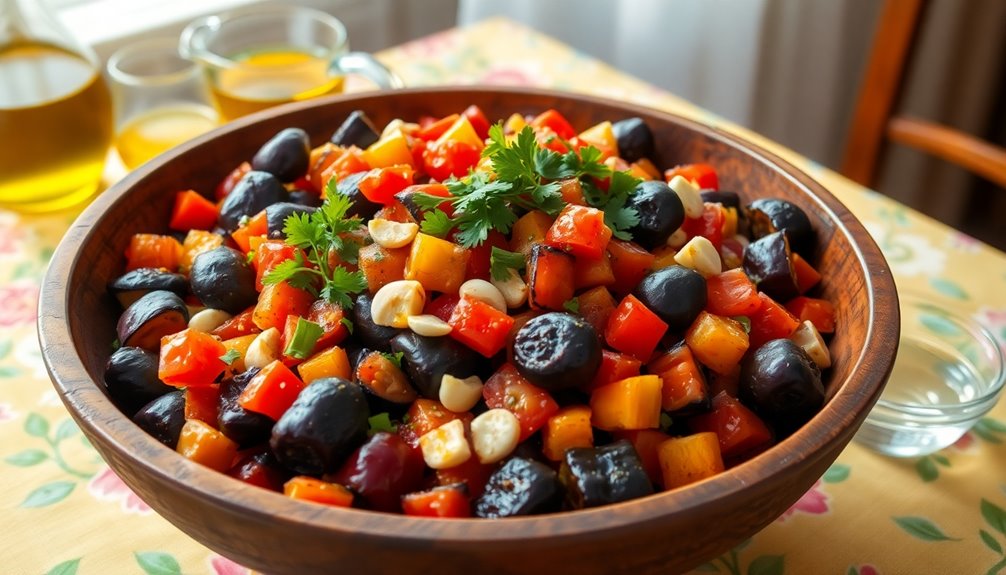
Combine the chopped roasted vegetables, tomatoes, and minced garlic in a large bowl for a vibrant flavor base.
You've just roasted and peeled the eggplants and peppers, so chop them into small pieces to make mixing easier.
Once everything's in the bowl, stir the ingredients together thoroughly, ensuring an even distribution of garlic and seasoning.
The balance of flavors is crucial for your eggplant dip, so adjust the vinegar and salt to taste.
Don't forget to sprinkle chopped parsley on top for added freshness and a beautiful presentation.
This step not only enhances the flavor but also elevates the dish's appearance, making it even more tempting for your guests. Additionally, serving with a side of freshly squeezed juices can complement the dish perfectly.
Enjoy your delicious creation!
Step 4. Add Olive Oil Mixture
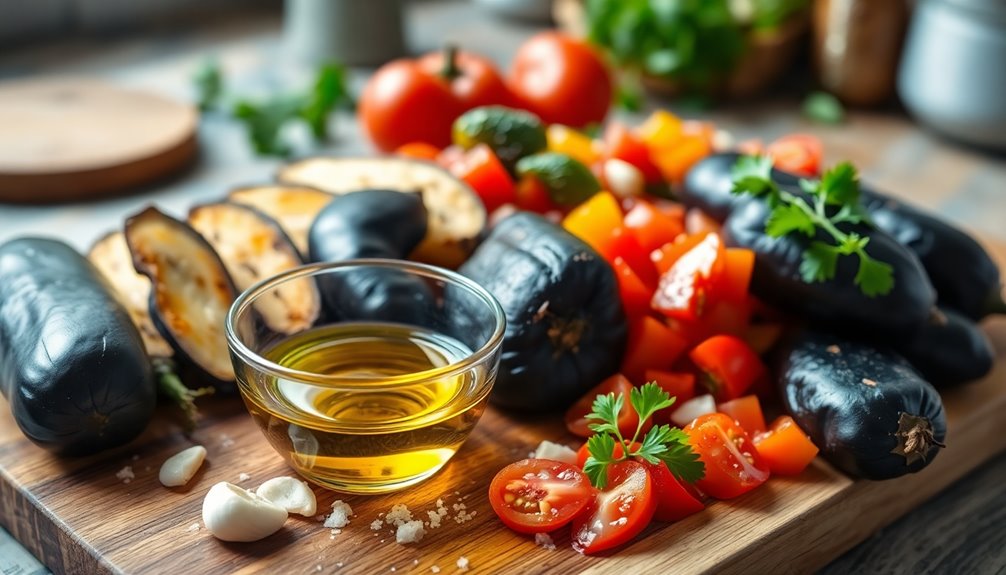
To elevate the flavor of your Kyopolou, you'll want to add a mixture of high-quality olive oil to the bowl of roasted vegetables.
Start by measuring out about 1/2 cup of olive oil, adjusting based on your preference for creaminess and smoothness. Drizzle the olive oil gradually into the mixture while stirring vigorously to ensure even distribution and to avoid an overly oily dip.
If you're feeling adventurous, try incorporating flavored olive oils like garlic-infused or chili-infused for an exciting twist.
After mixing, always taste your creation. You can adjust the seasoning with salt and vinegar as needed to achieve a perfectly balanced flavor.
This step is crucial for making your Kyopolou truly shine! Additionally, using high-quality olive oil can enhance the health benefits of your dish, as it is rich in antioxidants and healthy fats.
Step 5. Serve With Fresh Bread

Serving Kyopolou with fresh bread creates a delightful pairing that enhances the flavors of the dip.
To elevate this Bulgarian food experience, choose a crusty loaf like sourdough or baguette. Slice the bread into thick pieces, allowing for generous spoonfuls of the coarsely ground eggplant dip to spread on top.
For added enjoyment, toast the bread slightly; this enhances its flavor and creates a warm base for the cold dip. Before serving, garnish your Kyopolou with fresh parsley to add color and freshness that complements the bread beautifully.
To complete your traditional appetizer spread, offer a side of olives or pickles alongside the bread and Kyopolou, making every bite a taste of Bulgaria.
Final Thoughts
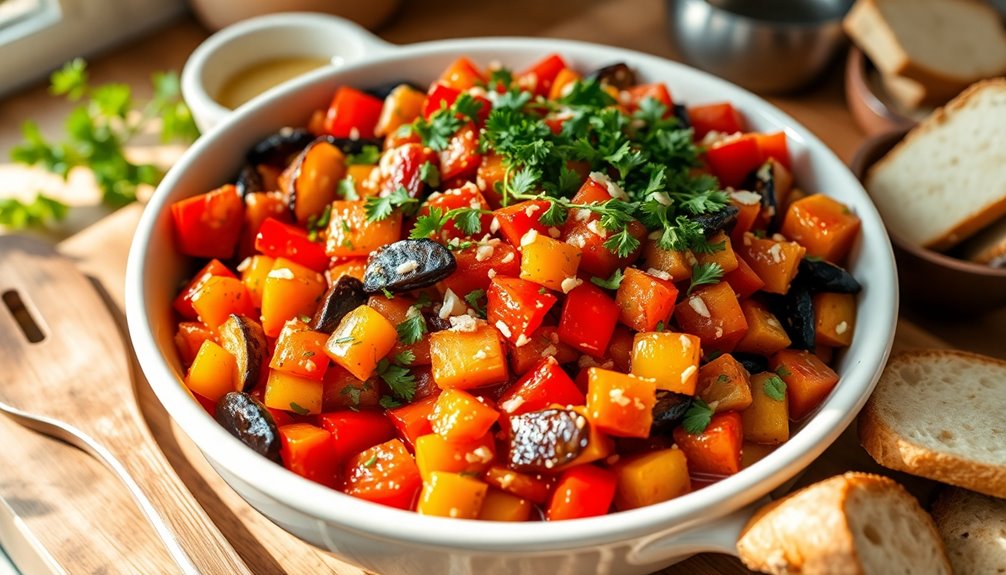
While exploring the rich flavors of Kyopolou, you'll discover not just a dish but a culinary tradition that bridges cultures.
This versatile spread, made from coarsely ground roasted eggplants, garlic, and peppers, captures the essence of Bulgarian and Turkish cuisine. Its popularity during Orthodox fasting periods highlights its satisfying, plant-based nature, making it a staple for many.
Whether enjoyed as a dip or spread, Kyopolou brings people together, especially in communal dining settings. You can easily prepare it at home or find it preserved in jars, ensuring you can savor its taste even during winter months.
Embrace the smoky, robust flavors of Kyopolou, and let it enhance your meals and gatherings with its rich heritage. Additionally, AI technologies can be utilized to analyze consumer preferences for traditional dishes like Kyopolou, ensuring its continued relevance in modern cuisine.
Frequently Asked Questions
Is Ajvar the Same as Kyopolou?
Ajvar isn't the same as Kyopolou.
While both are delicious Balkan spreads made from roasted vegetables, they've different flavor profiles and textures. Ajvar leans more on red bell peppers and tends to be smoother and spicier.
In contrast, Kyopolou focuses on roasted eggplants and garlic, creating a richer, savory taste.
What Is the Bulgarian Dish With Eggplant?
Did you know that eggplant is packed with antioxidants, making it a superfood?
In Bulgaria, one beloved dish featuring eggplant is the traditional roasted eggplant dip. It combines roasted eggplants, garlic, and often peppers and tomatoes, creating a flavorful blend.
You'll find it served cold, often as a dip or alongside bread. This dish not only highlights the vibrant flavors of summer and autumn but also embraces the essence of Bulgarian cuisine.
Enjoy!
Conclusion
In the journey of crafting kyopoolu, you're not just cooking; you're weaving a tapestry of flavors that tells a story. Each ingredient, like a vibrant thread, contributes to a rich narrative of taste and tradition. As you savor the final dish, think of it as a warm embrace from the past, inviting you to gather around the table with loved ones. So, let your kitchen be a canvas, and kyopoolu, the masterpiece that brings everyone together.
